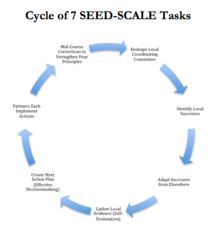SEED-SCALE
SEED-SCALE takes inspiration from several established figures within the financial field, such as former World Bank economist, according to Paul Collier, "change in societies at the very bottom must come primarily from within.
[4] The origins of SEED-SCALE began in UNICEF in 1992—when the then Executive Director James P. Grant was seeking a more accurate understanding of how to take successful pilot projects ("seeds") and to extend these to national level impact ("scale").
The thesis is that social change occurs within the complex intersection of people's values, economic dynamics, and environmental conditions (the socio-econo-info-biosphere), and that to either understand or to act in that complex world, answers do not directly follow from actions; they "emerge" out of interacting relationships in almost incomprehensible ways, obvious perhaps after the fact but impossible to predict ahead of time.
Whether literate or not, whether children, women, or men, they showed that they could map, list, rank, score, and diagram better than professionals.
"[8] Key contributions to the thinking also came from asset-based community development (ABCD)[9] and the theory of positive deviance.
As more people become involved, their energy stimulates demand for further rising quality of life (typically moving cross sectors such as from health to income generation).
[11] Future Generations Graduate School (FGGS) 2015 class, on a residential in India learned on the practical applicability of the SEED Scale in Sevagram (Feb. 09-March 12, 2014).

